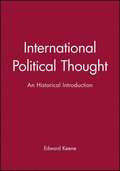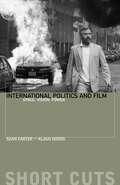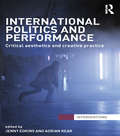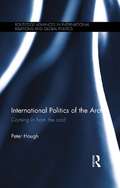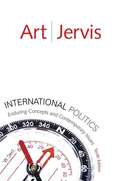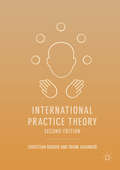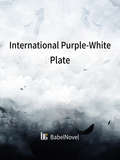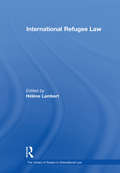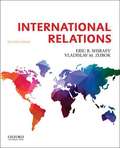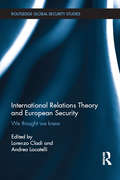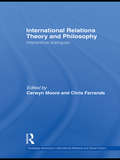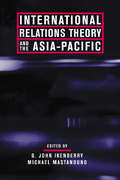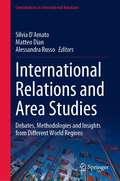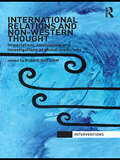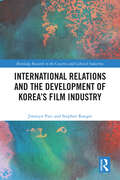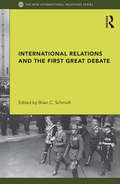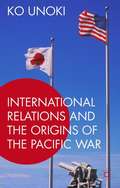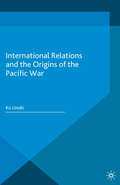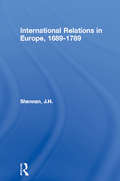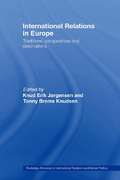- Table View
- List View
International Political Thought: A Historical Introduction
by Edward KeeneThis volume offers an accessible and wide-ranging introduction to the history of international political thought. Taking as its starting-point the various concepts people have used to think about differences between political communities, the book explores changing perceptions of international politics from antiquity to the twentieth century. As well as discussing well-known themes such as relations between independent sovereign states and the tension between raison d'etat and a universal code of natural law, it also examines less familiar ideas which have influenced the development of international political thought such as the distinction between civilization, national culture and barbarism, religious attitudes towards infidels, and theories about racial difference and imperialism. Among the key thinkers covered are Thucydides, Machiavelli, Hobbes, Kant, Marx and Morgenthau, alongside less commonly studied figures such as Herodotus, Pope Innocent IV, Herder, Constant and Zimmern. Each chapter concludes with a guide to further reading which will help students to develop a more detailed understanding of the subject. Written with the beginner student in mind, this lively textbook is an ideal introduction for anyone studying international political thought.
International Politics and Film
by Sean CarterInternational Politics and Film introduces readers to the representational qualities of film but also draws attention to how the relationship between the visual and the spatial is constitutive of international politics. Using four themes -- borders, the state of exception, homeland and distant others -- the territorial and imaginative dimensions of international affairs in particular are highlighted. But theis volume also makes clear that international politics is not just something 'out there'; film helps us better understand how it is also part of everyday life within the state -- affecting individuals and communities in different ways depending on axes of difference such as gender, race, class, age, and ethnicity.
International Politics and Film: Space, Vision, Power (Short Cuts)
by Klaus Dodds Sean CarterInternational Politics and Film introduces readers to the representational qualities of film but also draws attention to how the relationship between the visual and the spatial is constitutive of international politics. Using four themes—borders, the state of exception, homeland and distant others—the territorial and imaginative dimensions of international affairs in particular are highlighted. But this volume also makes clear that international politics is not just something "out there"; film helps us better understand how it is also part of everyday life within the state—affecting individuals and communities in different ways depending on axes of difference such as gender, race, class, age, and ethnicity.
International Politics and Performance: Critical Aesthetics and Creative Practice (Interventions)
by Jenny Edkins Adrian KearIn recent years we have witnessed an increasing convergence of work in International Politics and Performance Studies around the troubled, and often troubling, relationship between politics and aesthetics. Whilst examination of political aesthetics, aesthetic politics, and politics of aesthetic practice has been central to research in both disciplines for some time, the emergence of a distinctive ‘performative turn’ in International Politics and a critical return to the centrality of politics and the concept of ‘the political’ in Performance Studies highlights the importance of investigating the productivity of bringing the methods and approaches of the two fields of enquiry into dialogue and mutual relation. Exploring a wide range of issues including rioting, youth-driven protests, border security practices and the significance of cultural awareness in war, this text provides an accessible and cutting edge survey of the intersection of international politics and performance examining issues surrounding the politics of appearance, image, event and place; and discusses the development and deployment of innovative critical and creative research methods, from auto-ethnography to site-specific theatre-making, from philosophical aesthetics to the aesthetic thought of new securities scenario-planning. The book’s focus throughout is on the materiality of performance practices—on the politics of making, spectating, and participating in a variety of modes as political actors and audiences—whilst also seeking to explicate the performative dynamics of creative and critical thinking. Structured thematically and framed by a detailed introduction and conclusion, the focus is on producing a dialogue between contributors and providing an essential reference point in this developing field. This work is essential reading for students of politics and performance and will be of great interest to students and scholars of IR, performance studies and cultural studies.
International Politics of the Arctic: Coming in from the Cold (Routledge Advances in International Relations and Global Politics)
by Peter HoughThis book offers a wide-ranging account of the emerging issues of international politics in the Artic, and the emerging Geopolitical debates that surround the region. In this thorough but accessible book covering environmental issues, the author examines the Geopolitics of emerging land and resource disputes and the rise of both nationalist and pan-Arctic movements in the region. Whereas existing literature on the politics of the Arctic tends to focus either on the environment or on Geopolitical interests, this book considers both of these themes in addition to the politics of the region’s indigenous peoples and provides an overview on the emerging issues of international politics in the Arctic. The book makes full use of pedagogic features such as maps, diagrams, timelines, biographies and boxes highlighting key concepts and issues in order to make this an accessible book for both students and scholars alike. This book will be of interest to students and scholars of International Relations, Arctic Politics, Environmental Politics and European Politics.
International Politics: Enduring Concepts And Contemporary Issues, 10th Edition
by Robert J. Art Robert JervisFifty papers by scholars of economics, international relations, and related fields discuss the anarchic structure of international relations, the use of force, the international political economy, and contemporary world politics. Current issues like international cooperation, nuclear proliferation, globalization, terrorism, failed states, and climate change receive special attention.
International Practice Theory: Core Approaches
by Frank Gadinger Christian BuegerInternational Practice Theory is the definitive introduction to the practice turn in world politics, providing an accessible, up-to-date guide to the approaches, concepts, methodologies and methods of the subject. Situating the study of practices in contemporary theory and reviewing approaches ranging from Bourdieu’s praxeology and communities of practice to actor-network theory and pragmatic sociology, it documents how they can be used to study international practices empirically. The book features a discussion of how scholars can navigate ontological challenges such as order and change, micro and macro, bodies and objects, and power and critique. Interpreting practice theory as a methodological orientation, it also provides an essential guide for the design, execution and drafting of a praxiographic study.
International Purple-White Plate: Volume 1 (Volume 1 #1)
by Ju MenIn the early period of the Republic of China, the monks Rufeng and faming, who were in charge of protecting the state temple in Beijing, were chivalrous and righteous. I have a lot of experience in the Jianghu. Rufeng and faming led the monks to fight for life and death with the Japanese secret agents of the Black Dragon Society and the Japanese Kanto army who were rampant all over China at that time.
International Purple-White Plate: Volume 2 (Volume 2 #2)
by Ju MenIn the early period of the Republic of China, the monks Rufeng and faming, who were in charge of protecting the state temple in Beijing, were chivalrous and righteous. I have a lot of experience in the Jianghu. Rufeng and faming led the monks to fight for life and death with the Japanese secret agents of the Black Dragon Society and the Japanese Kanto army who were rampant all over China at that time.
International Purple-White Plate: Volume 3 (Volume 3 #3)
by Ju MenIn the early period of the Republic of China, the monks Rufeng and faming, who were in charge of protecting the state temple in Beijing, were chivalrous and righteous. I have a lot of experience in the Jianghu. Rufeng and faming led the monks to fight for life and death with the Japanese secret agents of the Black Dragon Society and the Japanese Kanto army who were rampant all over China at that time.
International Purple-White Plate: Volume 4 (Volume 4 #4)
by Ju MenIn the early period of the Republic of China, the monks Rufeng and faming, who were in charge of protecting the state temple in Beijing, were chivalrous and righteous. I have a lot of experience in the Jianghu. Rufeng and faming led the monks to fight for life and death with the Japanese secret agents of the Black Dragon Society and the Japanese Kanto army who were rampant all over China at that time.
International Refugee Law
by Hélène LambertThe essays selected and reproduced in this volume explore how international refugee law is dynamic and constantly evolving. From an instrument designed to protect mostly those civilians fleeing the worse excesses of World War II, the 1951 Refugee Convention has developed into a set of principles, customary rules, and values that are now firmly embedded in the human rights framework, and are applicable to a far broader range of refugees. In addition, international refugee law has been affected by international humanitarian law and international criminal law (and vice versa). Thus, there is a reinforcing dynamic in the development of these complementary areas of law. At the same time, in recent decades states have shown a renewed interest in managing migration, thereby raising issues of how to reconcile such interests with refugee protection principles. In addition, the emergence of concepts of participation and responsibility to protect promise to have an impact on international refugee law.
International Relations
by Vladislav M. Zubok Eric B. ShiraevUsing a three-part framework of Ideas, Arguments, and Contexts and Applications, International Relations, Second Edition, shows students how to think critically about issues and current events in world politics. Each chapter first describes key concepts and developments in the field (Ideas), then presents the main theoretical and analytical approaches (Arguments), and finally applies the main theories and approaches within the individual, state, and global contexts (Contexts and Applications). Historical information is woven throughout the text, and every chapter ends with an extended case study ("The Uses of History") that demonstrates how what we have learned from the past can influence our future actions. Three full chapters on key approaches--realism (chapter 2), liberalism (chapter 3), and constructivism and other alternative views (chapter 4)--introduce students to a broad spectrum of approaches, and each chapter integrates discussions of relevant theories and levels of analysis. Visual Reviews at the end of each chapter not only recap key points but include Critical Thinking questions that reflect the chapter learning objectives.
International Relations Theory and European Security: We Thought We Knew (Routledge Global Security Studies)
by Andrea Locatelli Lorenzo CladiThis book engages with key contemporary European security issues from a variety of different theoretical standpoints, in an attempt to uncover the drivers of foreign policy and defence integration in the EU. Although European foreign policy has been attracting an ever-increasing number of International Relations (IR) scholars since the end of the Cold War, consensus on what drives European foreign policy integration has not yet emerged. This book seeks to encourage debate on this issue by examining a wide range of high-profile security issues which have roused significant interest from policy makers, academics and the public in recent years. The volume discusses, amongst other issues, the strategic posture of the European Union as a security actor, the troubled relationship with Russia, the debate regarding France’s relations with the US following France’s rapprochement with NATO and the EU’s influence in the Israeli-Palestinian conflict. The collective intent of the contributors to highlight the drivers of EU foreign policy and defence integration ties together the wide variety of topics covered in this volume, forming it into a comprehensive overview of this issue. By paying considerable attention not just to the internal drivers of EU cooperation, but also to the critical role played by the US as an incentive or obstacle to European security, this book presents a unique contribution to this field of debate. This book will be of much interest to students of European security, IR theory, Transatlantic Relations, European politics and EU foreign policy.
International Relations Theory and Philosophy: Interpretive dialogues (Routledge Advances in International Relations and Global Politics)
by Cerwyn MooreThis book discusses the contribution of philosophers and thinkers whose ideas have recently begun to permeate international relations theory. It provides an introduction to the contemporary debates regarding theories and methodologies used to study international relations, particularly the relationships between interpretive accounts of social action, European philosophical traditions, hermeneutics and the discipline of international relations. The authors provides a platform for dialogue between theorists and researchers engaged in a more specific area studies, geo-political studies, political theory and historical accounts of international politics. The volume analyzes a variety of theoretical and explores the work of Nietzsche, Heidegger, Gramsci, Wittgenstein, Gadamer, Levinas, Bakhtin, Patocka, Derridean, Deleuze and Susan Sontag. Making an important contribution to discussions about how to study the complexities of world politics, this book will be of interest to students and researchers of international relations, politics, sociology, philosophy and political theory.
International Relations Theory and the Asia-Pacific
by Michael Mastanduno G. John. Ikenberry Eds.What will the Asia-Pacific rim look like in the years ahead? What tools will international relations theorists need to understand the complex relationship among China, Japan, and the United States as the three powers shape the economic and political future of this crucial region?Some of the best and most innovative scholars in international relations and Asian area studies gather here with the working premise that stability in the broader Asia-Pacific region is in large part a function of the behavior of, and relationships among, these three major powers. Each author analyzes the foreign policy behavior of one or more of these states and/or relations among them in an effort to make claims about the prospects for regional stability. Some of the chapters focus on security relationships, some on economic relations, and some on the interaction of the two. The authors do not promote any particular theoretical perspective, but instead draw on the full diversity of theoretical approaches in contemporary international relations scholarship to illuminate international interactions among the Pacific powers.The creative collaboration of international relations and Asian studies specialists presents the opportunity to assess the applicability of Western categories of analysis to the beliefs and behaviors of Asian actors. The scholars in this volume share the conviction that a deeper understanding of the effects of cultural divides between Asian and American policymakers is essential if the Pacific rim's economic and regional security is to be safeguarded.
International Relations Theory and the Asia-Pacific
by Michael Mastanduno G. John. IkenberryWhat tools will international relations theorists need to understand the complex relationship among China, Japan, and the United States as the three powers shape the economic and political future of this crucial region? Some of the best and most innovative scholars in international relations and Asian area studies gather here with the working premise that stability in the broader Asia-Pacific region is in large part a function of the behavior of, and relationships among, these three major powers.
International Relations and Area Studies: Debates, Methodologies and Insights from Different World Regions (Contributions to International Relations)
by Matteo Dian Alessandra Russo Silvia D'AmatoDiscover the intricate tapestry of international politics and governance with this book. The book delves into the diverse nature of globally significant actors and systems across multiple regions. From Africa to Asia, Europe to the Middle East, this collection of thought-provoking case studies explores the role of regional actors in the international system. Combining theoretical innovation with empirical analysis, this volume expands the boundaries of International Relations (IR) and Area Studies (AS), showcasing their interconnections throughout history and in contemporary contexts. Through illuminating case studies drawn from the fields of "Comparative Regionalism" and "Non-Western IR Theory," the book sheds light on pressing international events. Unpacking complex questions, the contributors examine the application of IR scholarship to global events and provide fresh insights into political dynamics, conflicts, and state instability across various regions. By offering a comparative perspective on threats, political contestation, and security policies, this book challenges existing perspectives and enriches the debate. With its methodological and epistemological explorations, this book is an indispensable resource for scholars and students of international relations and security studies, as well as researchers focusing on specific world areas. Embark on a captivating journey through the multifaceted landscape of global affairs.
International Relations and Non-Western Thought: Imperialism, Colonialism and Investigations of Global Modernity (Interventions)
by Robbie ShilliamInternational Relations, as a discipline, tends to focus upon European and Western canons of modern social and political thought. Alternatively, this book explores the global imperial and colonial context within which knowledge of modernity has been developed. The chapters sketch out the historical depth and contemporary significance of non-Western thought on modernity, as well as the rich diversity of its individuals, groups, movements and traditions. The contributors theoretically and substantively engage with non-Western thought in ways that refuse to render it exotic to, superfluous to or derivative of the orthodox Western canon of social and political thought. Taken as a whole, the book provides deep insights into the contested nature of a global modernity shaped so fundamentally by Western colonialism and imperialism. Now, as ever, these insights are desperately needed for a discipline that is so closely implicated in Western foreign policy making and yet retains such a myopic horizon of inquiry. This work provides a significant contribution to the field and will be of great interest to all scholars of politics, political theory and international relations theory.
International Relations and the Development of Korea’s Film Industry (Routledge Research in the Creative and Cultural Industries)
by Jimmyn Parc Stephen RangerThis book examines the evolution of the Korean film industry, presenting a comprehensive account from the early days of experimental screening to its current period of attracting increased foreign investment.Exploring the Korean film industry’s troubled past, this book covers occupation, civil war, authoritarianism, globalisation, and the continued uncertainties amidst geopolitical competition. It differs from other existing works by connecting the development of the Korean film industry to the country’s international relations. Furthermore, it considers what impact this had on the industry itself rather than just on the content of the films produced. With such an approach, this book reveals the background and reasons for its achievements, ultimately providing an inspiring example of global success and an applicable benchmark for other film industries seeking their own international breakout.By offering fresh insights and new information linking the past and present of the Korean film industry, the book serves as a useful companion to scholars of cultural studies, business history, Korean studies, and globalisation, even if they may not be familiar with the specifics of this dynamic industry. Moreover, this book can serve as a valuable reference for shaping the roadmap of audiovisual sectors—including the film industry—toward a promising future.
International Relations and the First Great Debate (New International Relations)
by Brian C. SchmidtThis book provides an authoritative account of the controversy about the first great debate in the field of International Relations. Of all the self-images of International Relations, none is as pervasive and enduring as the notion that a great debate pitting idealists against realists took place in the 1940s. The story of the first great debate continues to structure the contemporary identity of International Relations, yet in recent years revisionist historians have challenged the conventional wisdom that the field experienced such a debate. Drawing on expert contributors working in Canada, Europe, the United Kingdom, and the United States, this book includes key participants in the historiographical controversy. The book assembles the existing scholarship and provides a thorough analysis of the status of the first great debate in the history of International Relations. It is an invaluable examination of the causes and future direction of idealist and realist arguments. International Relations and the First Great Debate will be of interest to students and scholars concerned with the foundations of International Relations.
International Relations and the Origins of the Pacific War
by Ko UnokiInternational Relations and the Origins of the Pacific War takes the unique approach of examining the history of the relationship between Japan and the United States by using the framework of international relations theories to search for the origins of the Pacific War, that erupted with Japan's attack on Pearl Harbour in 1941.
International Relations and the Origins of the Pacific War
by Ko UnokiInternational Relations and the Origins of the Pacific War takes the unique approach of examining the history of the relationship between Japan and the United States by using the framework of international relations theories to search for the origins of the Pacific War, that erupted with Japan's attack on Pearl Harbour in 1941.
International Relations in Europe, 1689-1789 (Lancaster Pamphlets)
by J. H. ShennanShennan examines the changing criteria upon which European relations were based between 1689 and 1789, a complex period which saw: * the decline of dynasticism * the emergence of economic power as a concomitant of military might * the growth of British influence * the dawn of nationalism For easy reference, this book also contains extensive chronologies of the important battles, treaties and alliances of the period, along with a list of further reading.
International Relations in Europe: Traditions, Perspectives and Destinations (Routledge Advances in International Relations and Global Politics #Vol. 44)
by Knud Erik Jørgensen Tonny Brems KnudsenA new and illuminating critical examination of international relations in Europe. This new volume presents all of the state of the art thinking, focusing particularly on international relations theory and theoretical debates in Western and Central European countries.The contributors seek to strengthen knowledge about different ways of cultivating the discipline; to intensify pan-European communication concerning IR theory; to contribute to improving the quality of theorizing; and finally to consider future directions for the discipline in Europe. The main issues addressed include: the historical development of the discipline; factors driving IR theorizing; the institutional and cultural context of theorizing; 'homegrown' theory-building vs. theory import; patterns of traditional and new discourse; and the diversity of disciplinary traditions.
